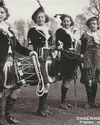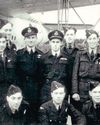
The rescue of two downed aircraft crews, by Sunderland flying boat T9114 from Pembroke Dock is one of the most remarkable of its kind undertaken during World War Two.
RAF Pembroke Dock, on the south side of Milford Haven Waterway, was Britain's largest base for flying boats during World War Two. In 1943, 99 seaplanes occupied the waterway or were located on land.
In the early 1940s, Pembroke Dock and the town suffered heavily from German air raids due to its military importance and location of the nearby oil refineries.
Despite this, British military operations continued at a pace to win the crucial Battle of the Atlantic.
On 28 May 1943, Sunderland flying boat JM675 (codenamed UT-O), from Royal Australian Air Force No 461 Squadron, took off on an operational patrol to rescue the crew of a downed Armstrong Whitworth Whitley bomber.
These flying boat squadrons which operated from Pembroke Dock undertook numerous wartime roles including reconnaissance, tracking enemy shipping, anti-submarine warfare, air-sea rescue, and convoy escort. Patrols could last up to 12 or 13 hours where a solitary aircraft might patrol 500 miles out into the Atlantic.
At 5.30pm, the operational Sunderland spotted a dinghy with survivors and radioed in for permission to land. The Sunderland then began to land over moderate seas, but bounced off three swells, stalled and finally dived vertically into the next. The bow of the cockpit was ripped off, killing Captain F/Lt Dods and leaving the first pilot badly injured. The survivors managed to clamber into a "J" dinghy and joined up with the survivors of the downed Armstrong Whitworth Whitley. They then lashed their dinghies together and waited.
This story is from the December 2024 edition of Best of British.
Start your 7-day Magzter GOLD free trial to access thousands of curated premium stories, and 9,000+ magazines and newspapers.
Already a subscriber ? Sign In
This story is from the December 2024 edition of Best of British.
Start your 7-day Magzter GOLD free trial to access thousands of curated premium stories, and 9,000+ magazines and newspapers.
Already a subscriber? Sign In

Animal Magic
Hilary Middleton recalls a children's author whose tales are still enjoyed today

BACK IN TIME WITH COLIN BAKER
BoB's very own Time Lord prepares for an alternative to panto, recalls his early reading choices and having his scenes cut from two cutting edge comedies

Marvels in Miniature
Claire Saul learns about the exquisite works on display at a new exhibition being held at a historic Georgian mansion

The Last Post
Michael Foley witnessed the end of an era

The Box of Delights
Chris Hallam remembers how his Christmas 40 years ago was lit up by a magical television drama

The Queen of Stage and Screen
Chris Hallam pays tribute to actress Dame Maggie Smith

Other 07
Jonathan Sothcott looks at the seven Sir Roger Moore films that you should have in your collection

In the Best Possible Taste
Derek Lamb remembers the wireless wizardry of Kenny Everett

POSTCARD FROM BUCKINGHAMSHIRE
Bob Barton remembers a ghostly train journey, enjoys some wassailing and fulfils a long-held ambition of attending a lawnmower festival

MERCY MISSION
John Greeves recounts the remarkable exploits of Sunderland flying boat T9114